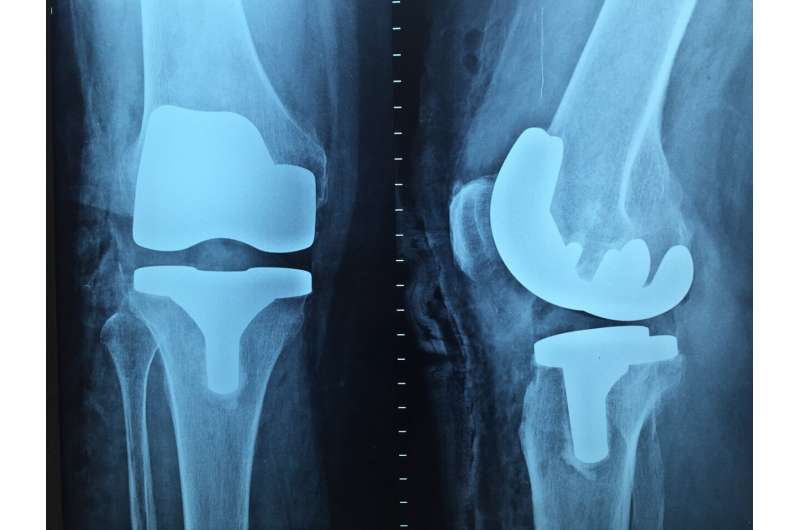This article has been reviewed according to Science X's editorial process and policies. Editors have highlighted the following attributes while ensuring the content's credibility:
fact-checked
peer-reviewed publication
trusted source
proofread
New strategy to protect bones during cancer treatment uses unique drug delivery system

Cancer patients who receive radiation during their treatment—and about half do—may face a lesser-known challenge: bone loss. The vital treatment for cancers of the head and neck, breast, cervix, prostate, and even eyes can harm the cells that keep bones strong.
But Duke University School of Medicine and the University of Texas MD Anderson Cancer Center have developed a new strategy to protect bones during cancer treatment using a unique drug delivery system with tiny carriers. Researchers shielded bone-forming cells in mice after radiation by targeting a specific protein with a recently approved medication.
Their study published Nov. 29 in Science Translational Medicine could help tackle the common issue of radiation-induced bone loss that can leave patients prone to bone fractures years after becoming cancer-free.
"As more patients survive cancer, the focus isn't just on the primary battle, but also ensuring a better quality of life beyond treatment," said senior study author Colleen Wu, Ph.D., assistant professor in orthopedic surgery, cell biology, and pharmacology and cancer biology at Duke University School of Medicine.
Repurposing for bone protection
Wu, an affiliate of the Duke Regeneration Center, researches the role of skeletal progenitor cells in bone regeneration. The cells help build cartilage and bone. But could they be counted on to rescue bones after radiation exposure?
Researchers found that suppressing the specific factor called hypoxia-inducible factor-2a with the drug PT2399 could protect bone-forming cells from radiation. It's a potential new use for the drug that the U.S. Food and Drug Administration approved two years ago to treat certain types of kidney cancers.
Also known as belzutifan, it was called PT2399 during development at UT Southwestern as an HIF-2 inhibitor.
When researchers used the drug to inhibit HIF-2, it increased the number of skeletal progenitor cells and enhanced their ability to form new bone
According to the study, 14 days after radiation exposure, mice without HIF-2 had 2.5 times as many Lepr-tdTm+ cells, a type of skeletal progenitor cell, compared to a control group.
However, the genetic alterations in the mouse model may not precisely mirror a human response, and authors note there are many types of bone cells, including osteoblasts, adipocytes, and stromal progenitors. The variability can impact how different cells react to radiation therapy.
Precision delivery for maximum impact
One challenge in using HIF-2 inhibitors for treatment is the development of anemia. HIF-2 regulates the expression of erythropoietin (EPO), a growth factor necessary for red blood cell production. Systemic administration of HIF-2 inhibitors often leads to decreased EPO expression and, consequently, anemia.
"Unfortunately, 90% of patients who receive this therapy develop anemia," Wu said. "In fact, we also observed signs of anemia in our animals treated systemically with the HIF-2 inhibitor, PT2399."
To address the issue, Wu and study co-author Cullen M. Taniguchi, MD, Ph.D. of MD Anderson, turned to biomedical engineers.
Shyni Varghese, Ph.D., professor of biomedical engineering, mechanical engineering & materials science, and orthopedic surgery at Duke University, led the development of a bone-targeting nanocarrier formulation of PT2399.
Because of their size, nanocarriers, which can be smaller than the thickness of a strand of hair, can transport drugs right to cells.
"By delivering PT2399 directly to the bone, we found that not only were we able to prevent bone injury after radiation exposure, but we were able to prevent the development of anemia," Wu said.
Working together, scientists tested a new use for a known drug and used it in a unique way to lessen its side effects.
"This highlights the value of collaborative work in science," Wu said. "Without the combined support and expertise, we would not have been able to carry out the work and make such an exciting discovery with clinical applications for the treatment of radiation-induced bone loss."
More information: Wendi Guo et al, Radiation-induced bone loss in mice is ameliorated by inhibition of HIF-2α in skeletal progenitor cells, Science Translational Medicine (2023). DOI: 10.1126/scitranslmed.abo5217



















